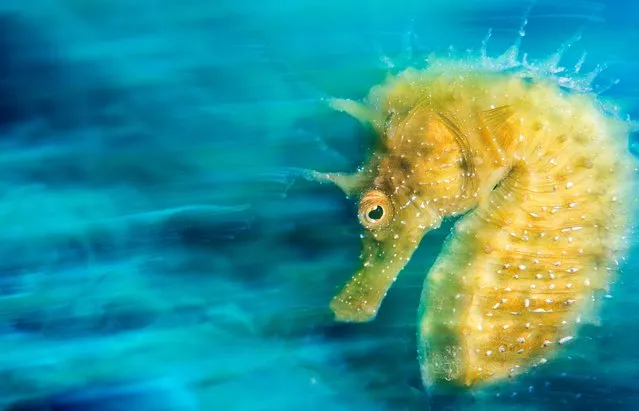
Underwater photographer of the year – winner. Gold by Davide Lopresti (Italy). Location: Sistiana – Trieste, Italy. “Over the years the Mediterranean’s population of seahorses has drastically reduced. Their numbers have only recovered thanks to public awareness and a significant restocking campaign ... For this shot, I used a long exposure and camera panning, to give dynamism to the image. I then used a focused beam of light from my strobe to freeze the details in the subject. My aim was to give the scene a sense of grace and strength simultaneously”. (Photo by Davide Lopresti/Underwater Photographer of the Year 2016)
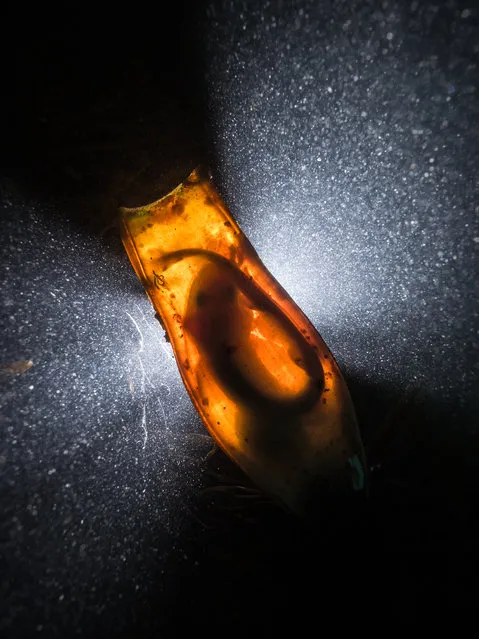
British underwater photographer of the year – winner, also winner, British macro category. Catshark Supernova by Dan Bolt (UK). Location: Thurlestone, Devon, UK. “Just off a headland in this beautiful bay is a reef system favoured as a laying ground for the eggs, or ‘mermaids purse’ of the smallspotted catshark. The day I chose to visit the reef I came across many egg cases wrapped tightly into the weed. Positioning my strobe carefully took some time but the resulting image, with the low-visibility providing a celestial-like quality, shows the hidden beauty within this system of reproduction”. (Photo by Dan Bolt/Underwater Photographer of the Year 2016)
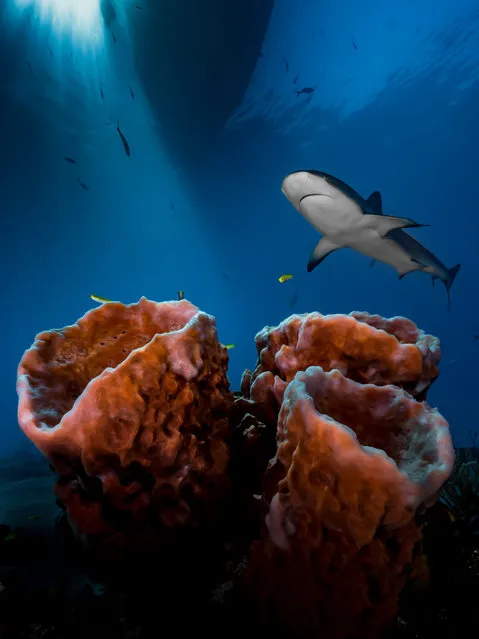
Up & coming underwater photographer of the year, also winner, up & coming worldwide category. Three Pillars – Practice, Patience & Luck! by Pier Mane (South Africa). Location: Tiger Beach, Bahamas. “Weary of shooting sharks head-on ... I decided to turn away from the peak action ... I wanted sun rays, dramatic foreground, background perspective, and – the cherry on top – to capture the “master of the house” in all of its mystique. The three sponges were well-positioned to set the scene and it took countless shots to balance the elements; but perseverance, patience and practice all paid off”. (Photo by Pier A. Mane/Underwater Photographer of the Year 2016)

Most promising British underwater photographer. Fired up and “almost” ready to go by Marty Engels Dunmore (UK). Location: USS Kittiwake, Grand Cayman. “These days it isn’t easy to produce a unique image of this well-loved wreck ... In 18 metres of water I found this wonderful old machine, an old diving compressor made by the Rix company. The photo was taken without any strobes, but with aid of my dive-torch, which I positioned within the engine to give an extra focal point and the sense of a fire still burning”. (Photo by Marty Engels Dunmore/Underwater Photographer of the Year 2016)

Wide-angle category winner. Underwater fisherman by Mike Korostelev (Russia). Location: Kuril Lake, Russia. “Cages are more commonly associated with photographing sharks, but I constructed a cage to keep me safe as I captured the fishing behaviour of the bear. I waited many hours in the cold water for the bear to come close enough. The bear’s strategy is to start by sitting down, putting his head under the water and looking for fish. Once the fish start to ignore him, he creeps closer before making his crucial lunge to snare a large salmon in his paws, or teeth”. (Photo by Mike Korostelev/Underwater Photographer of the Year 2016)
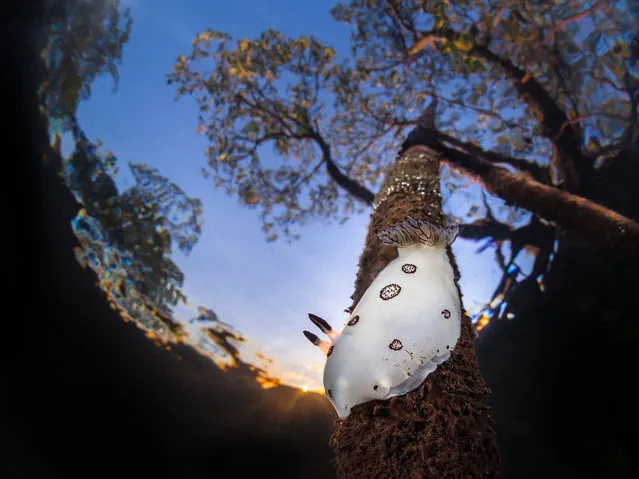
Wide-angle runner-up. Mangrove sunset by Fabio Galbiati (Italy). Location: Bangka island, Indonesia. “On the first days of my trip, the bad weather prevented us from diving. So we took advantage of the pristine mangrove nearby. It was a big surprise because there were so many subjects everywhere and the light effects produced by the sun and mangroves were beautiful. I decided to make a shot at sunset, and after a long search I found the right root with this nudibranch intent on feeding. After framing to restrict the backscatter I only had to wait for the sun to do its duty and press the shutter!”. (Photo by Fabio Galbiati/Underwater Photographer of the Year 2016)
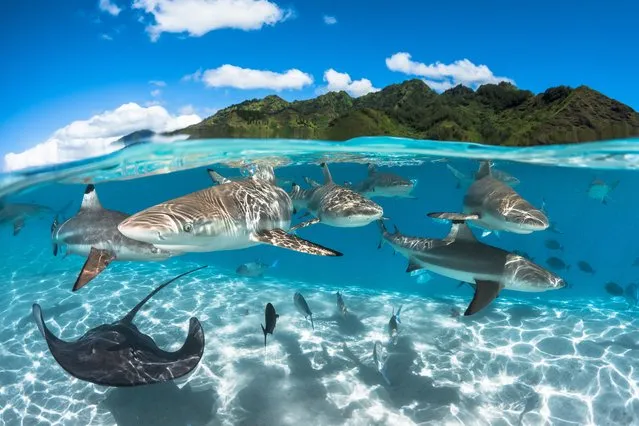
Wide-angle category third place. Lagoon by Greg Lecoeur (France). “French Polynesia is an amazing place for nature lovers. In the lagoon of Moorea I was snorkeling with an abundance of marine life, most notably these black tip sharks. The topography of the mountains in the background inspired me to realise this half and half photo”. (Photo by Greg Lecoeur/Underwater Photographer of the Year 2016)
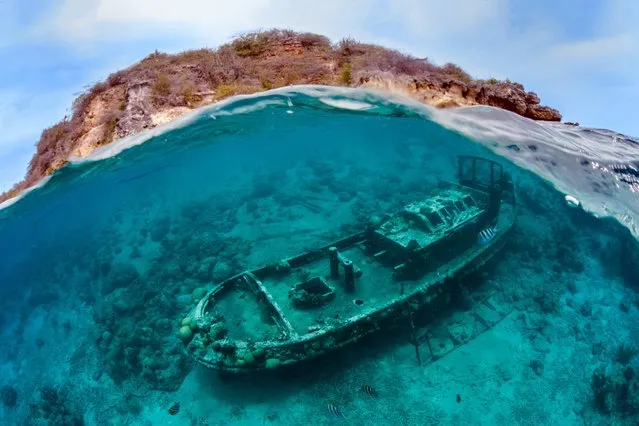
Macro category winner. A Family Affair by Thomas Heckmann (Germany). Location: Tugboat, Curacao. “I was unable to descend ... so my only possibility was a shot from the surface. It was too rough for a normal over/under shot. I decided to try a wave and wreck shot with the island of Curacao in the background. I needed several tries to compose the wreck, the wave and the island in one shot. But at the end I got this real over/under shot with a total other view of the famous wreck”. (Photo by Thomas Heckmann/Underwater Photographer of the Year 2016)
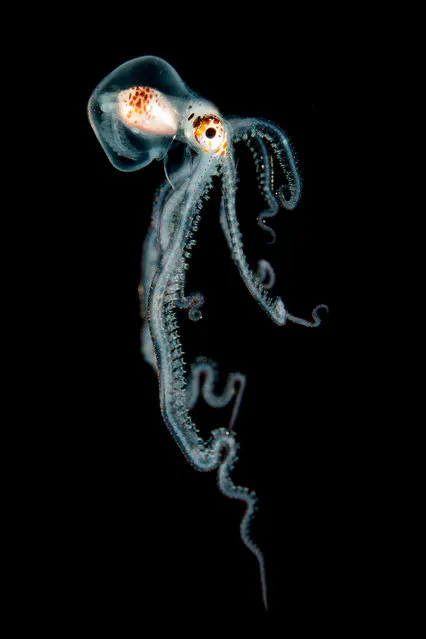
Macro category runner-up. Pelagic Octopus at Night by Helen Brierley (US). Location: Kona, Hawaii. “Suspended in the inky blackness of the open ocean where the water is thousands of feet deep, a myriad of weird and wonderful creatures came into view in the narrow focus light beam. They were making their nightly journey towards the surface to feed. Using our lights to help locate their prey ... I was able to take several shots of this tiny octopus as he drifted by, but he disappeared again into the darkness all too soon”. (Photo by Helen Brierley/Underwater Photographer of the Year 2016)
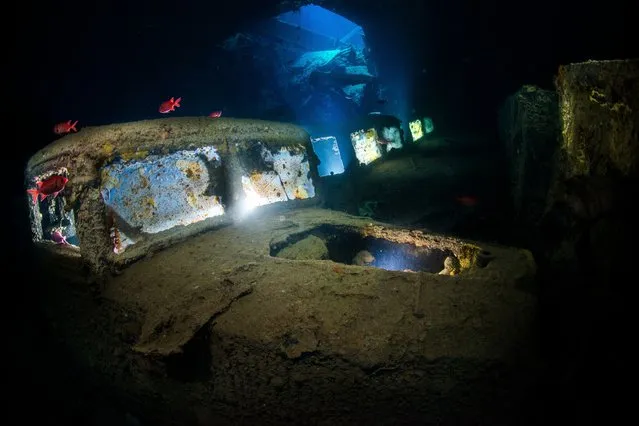
Macro category runner-up. Truck Parking by Anders Nyberg (Sweden). Location: SS Thistlegorm, Egypt, Red Sea. “I really like the SS Thistlegorm and can not get enough of this beautiful wreck. What makes the wreck so unique is the great opportunity to create stunning wreck images, especially if you add one or more off camera strobes to create more depth in the image. For lighting, my buddy and I placed the 3 off camera strobes, one strobe in each truck and a torch in the engine compartment in the first truck. I could easily spend many dives entirely inside this captivating wreck”. (Photo by Anders Nyberg/Underwater Photographer of the Year 2016)
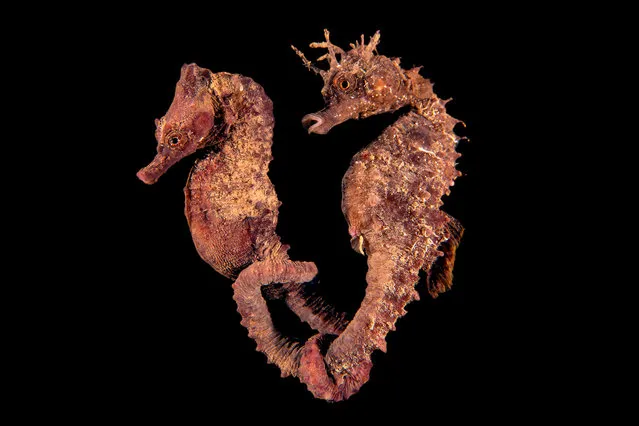
Macro category third place. The odd couple by Gianni Colucci (Italy). Location: Taranto, Italy. “During a night dive at around midnight, I found this pair of seahorses. I watched, mesmerised as they swam in the shallows holding each other by the tail. The scene was something majestic, a magic only enhanced by the beauty of the location, illuminated by the full moon”. (Photo by Gianni Colucci/Underwater Photographer of the Year 2016)
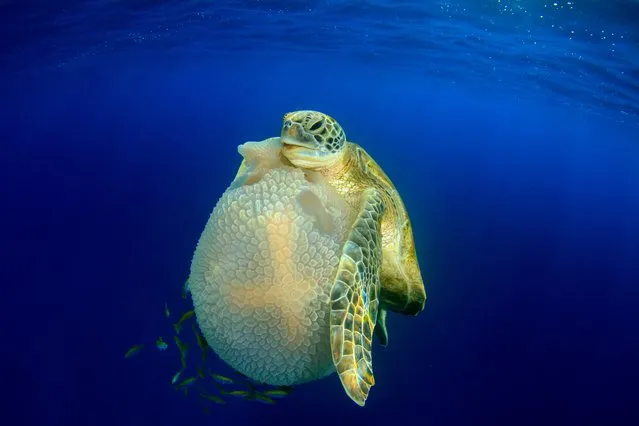
Behaviour category winner. Turtle eating Jellyfish by Richard Carey (Thailand). Location: Similan Islands, Thailand. “After an early morning dive in the Similan Islands ... a green turtle surfaced near our boat. I decided to get in and snorkel with it ... soon it spotted a large mosaic jellyfish ... dived down and started feeding on it. The turtle obviously wanted to keep the jelly close to the surface so every time it swam deeper the turtle would bite onto it and drag it back upwards. I spent a few minutes watching it and taking photos, and then left the turtle to finish his meal in peace”. (Photo by Richard Carey/Underwater Photographer of the Year 2016)
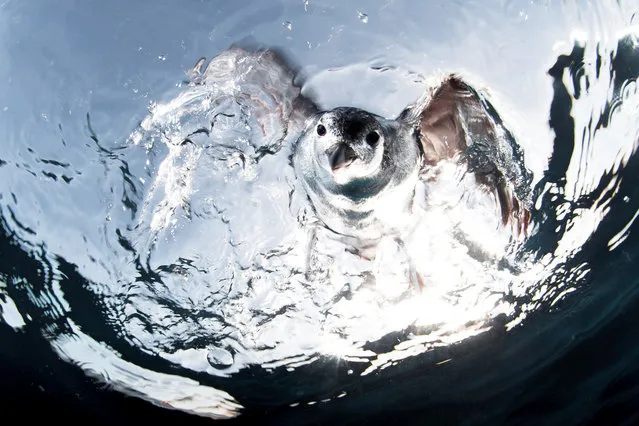
Behaviour category runner-up. What Feed Beneath by Alejandro Prieto (Mexico). “I entered the cold November water to photograph a pair of humpback whales ... swimming back to the boat I saw a small moving object in front of me; it was a Hawaiian petrel submerging its head to feed on the tiny crustaceans. Under normal circumstances as you get close it will fly away, but surprisingly instead of this it just kept feeding in front of me. By approaching very slowly I was able to get close from beneath, thankfully it stayed there for a few moments allowing me to capture this behaviour”. (Photo by Alejandro Prieto/Underwater Photographer of the Year 2016)
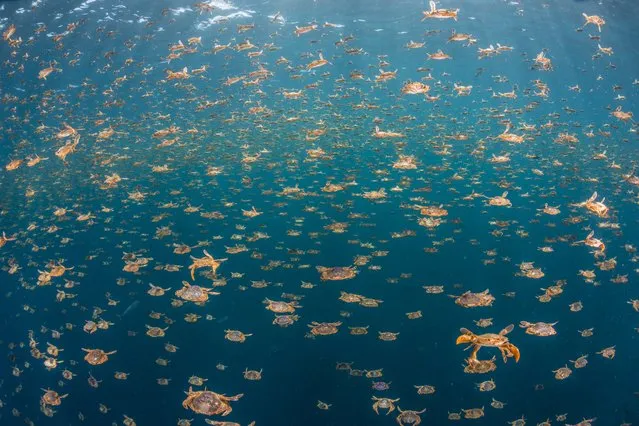
Behaviour category third place. Millions of crabs by Rui Guerra (Portugal). Location: Berlengas natural reserve, Portugal. “Every year, millions of crabs form large red masses in places along the coast of Portugal. This high density of swimming crabs is somewhat rare. On this day we first spotted some dispersed crabs, but it took us almost an hour to find a higher concentration. And a further 20 minutes of blue-water diving until I noticed this immense “red cloud” made up of maybe several thousand crabs swimming through the water”. (Photo by Rui Guerra/Underwater Photographer of the Year 2016)
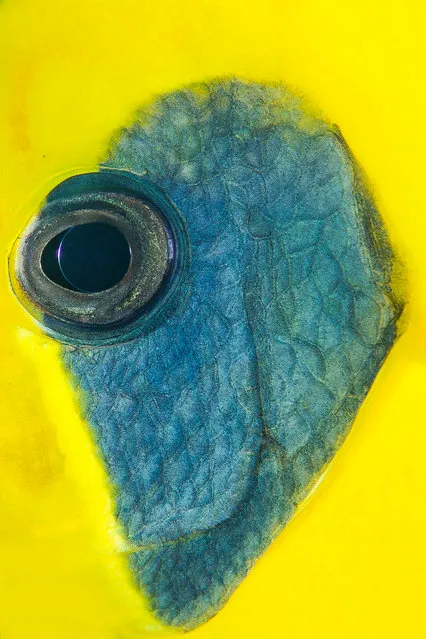
Up & coming category third place. The Eye of a Butterfly by Spencer Burrows (UK). Location: Sharks Bay House Reef, Egypt. “While masked butterflyfish are fairly common in the Red Sea, they are quite skittish and often swim away on approach. As I wanted to try and capture this common fish in a different way I had an abstract shot in mind and I felt the eye with its blue and yellow surroundings were key to the shot working. Having failed to get this to work with a standard macro lens, I equipped a tele-converter for additional reach, which allowed me to keep my distance from the fish”. (Photo by Spencer Burrows/Underwater Photographer of the Year 2016)
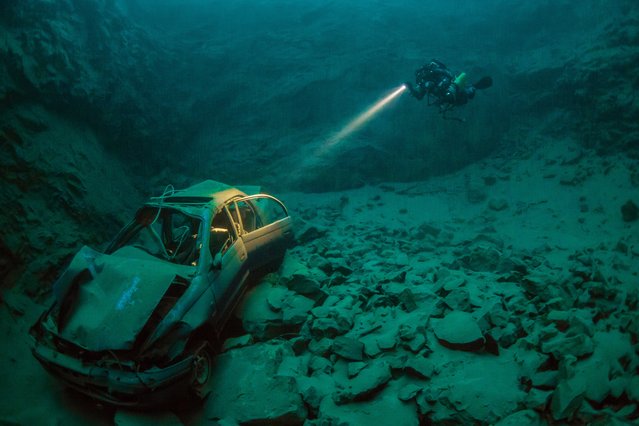
Wide-angle category winner. Part of the Illusion by Marcus Blatchford (UK). Location: National Dive & Activity Centre, Chepstow, Wales. “This is the deepest inland dive centre in the UK. The dive plan was to explore the deep end, but this time I dived ‘unplugged’ (without my strobes). With the exception of this change to my camera technique, there were no planned shots I wanted to achieve – just a fun dive with ad-hoc photos along the way. Shortly after this photo was captured, in 6C water and two hours of decompression ahead of us, we turned and started the long ascent back to the surface”. (Photo by Marcus Blatchford/Underwater Photographer of the Year 2016)
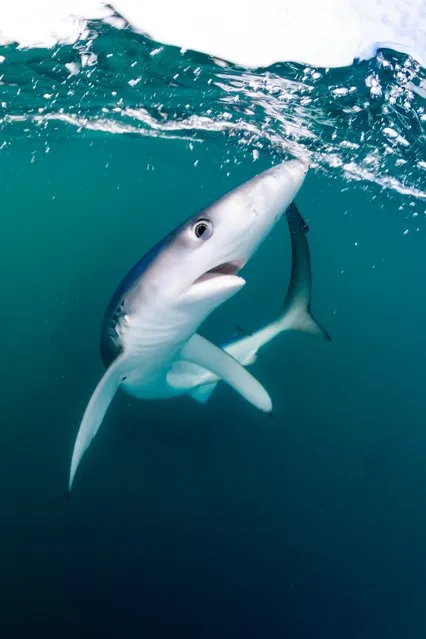
British waters wide-angle category runner-up. Shocked Shark by Will Clark (UK). Location: Penzance, Cornwall, UK. “This juvenile blue shark was the first to arrive at our boat after an hour of chumming. We were alerted to its presence by the bobbing of a small buoy which had fresh mackerel tied to it. I leaned over the side of the boat with my camera housing not quite fully submerged as the skipper tried to coax the shark nearer to the boat. He got the blue very close to me, and then just at the last moment he whipped the bait out of the water, which got this reaction from the shark”. (Photo by Will Clark/Underwater Photographer of the Year 2016)
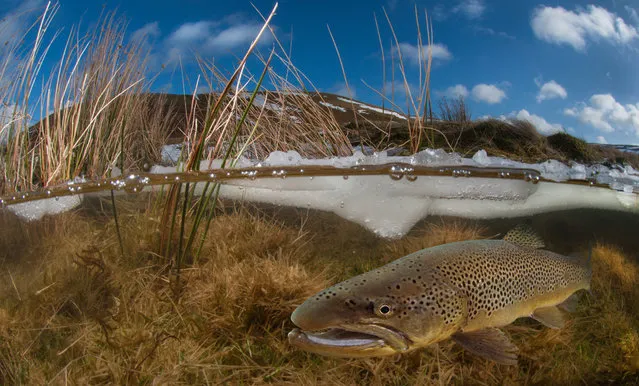
British waters wide-angle category third place. Elan valley trout in winter by Trevor Rees (UK). Location: Elan Valley, Powys, Wales. “This is a half-and-half scene taken on a snowy January morning. I have used my fisheye lens ... The brown trout has been subsequently added to the scene in Photoshop so this is very much a composite image. The trout is actually shot at a completely different time and location. The inspiration for the image may be from images I have seen of migrating salmon struggling up a river to then be found lying exhausted – a poor substitute I know, but I like the effect”. (Photo by Trevor Rees/Underwater Photographer of the Year 2016)
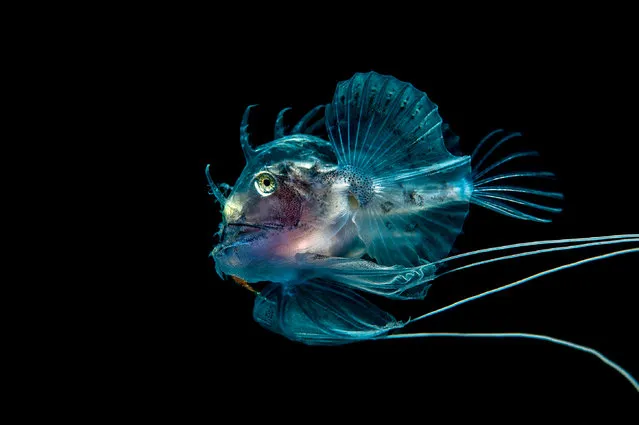
British macro category runner-up. Planktonic Predator by George Stoyle (UK). Location: North Rona, UK. “We had come to the end of a dive inside a cave, just before we reached the surface we noticed an unusual amount of zooplankton which had become trapped inside the cave entrance. We then spotted a couple of tiny, post-larval monkfish feeding on the plankton, something none of us had ever seen. Getting an in-focus shot with my macro lens was easier said than done with prevailing swell, but I managed a few before the boat came to pick us up”. (Photo by George Stoyle/Underwater Photographer of the Year 2016)
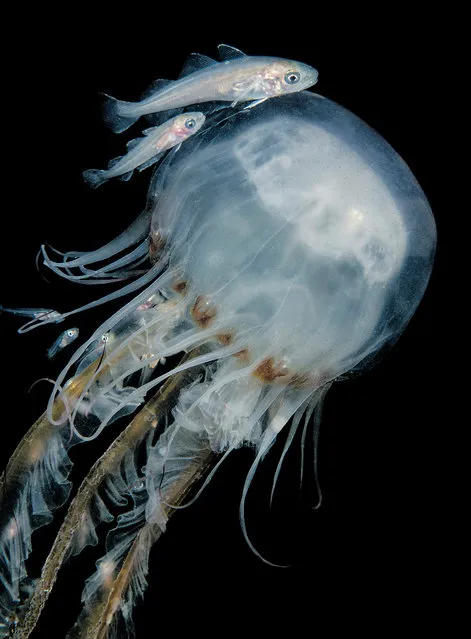
British macro category third place. Safe haven by Cathy Lewis (UK). Location: Plymouth, UK. “The water was thick with plankton and a strong current was funnelling small compass jellyfish towards the wreck of the Scylla. Some were host to a large number of juvenile codfish which use them for protection. The larger fry were perched on top while the smaller ones swam among the tentacles, avoiding being stung. Photographing the highly reflective silver fry was a frustrating challenge, but I have never seen so many fish crammed into such small jellies so I knew I was witnessing something rather special”. (Photo by Cathy Lewis/Underwater Photographer of the Year 2016)
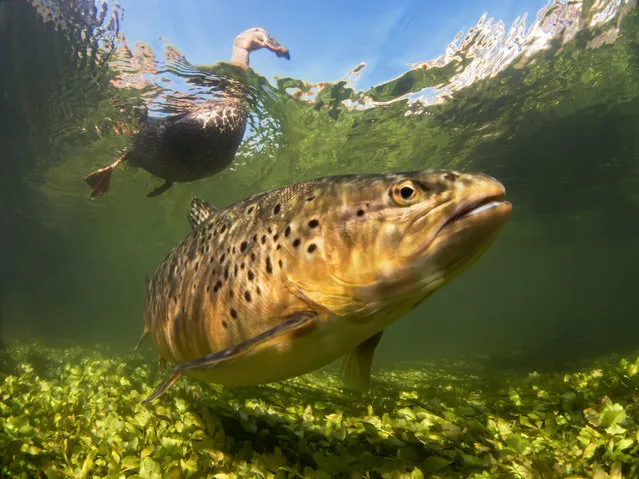
British waters compact category winner. Hello Ducky! by Paul Colley (UK). Location: river Test, Hampshire, UK. “While trying to photograph trout with a home-made pole-cam, a raft of mallard ducks muscled in to steal food intended to entice trout to the camera. This initial nuisance became an interesting opportunity and, shooting blind with the camera on the pole, I managed to catch the trout below water with a duck swimming overhead ... This needed a low viewpoint, an upward camera angle and a metric tonne of patience to allow all the elements to come together and make the picture work”. (Photo by Paul Colley/Underwater Photographer of the Year 2016)
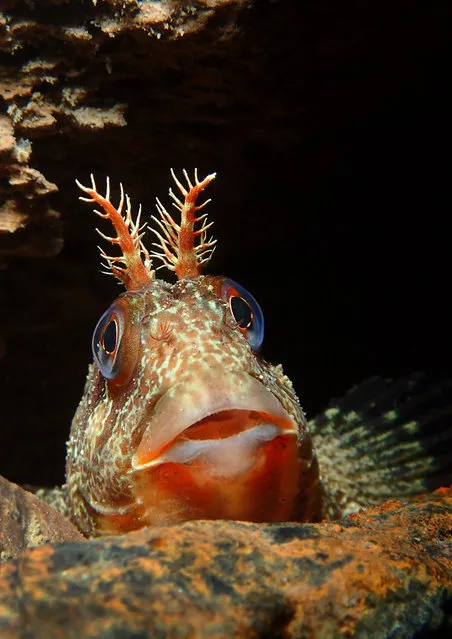
British waters compact category runner-up. Tompot looking out by Trevor Rees (UK). Location: Trefor Pier, north Wales. “This tompot blenny was hiding in a hole among the legs of a sea pier. Some of these fish are quite shy while others are rather inquisitive ... This one was happy to pose for as long as I needed ... I made sure I had both the fish’s eyes facing forward and that the head tentacles were isolated against a black background ... I opted for an off-centre composition with quite a lot of negative space to perhaps give a slightly different feel to my take on this fish”. (Photo by Trevor Rees/Underwater Photographer of the Year 2016)
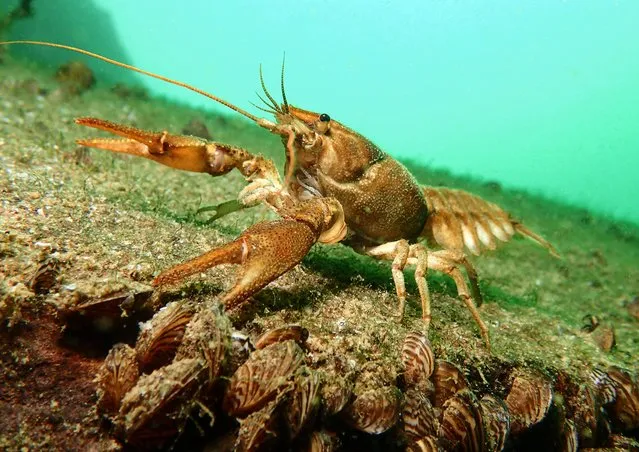
British waters compact category third place. British native crayfish by Trevor Rees (UK). Location: Stoney Cove, Leicestershire, England. “The crayfish at this freshwater quarry are all native and there are a good number to be seen. I found the small form factor of a compact camera ideal for holding at arm’s length to get a low angle and to get close to an individual that was nicely out in the open. The auto exposure only nature of my camera was restricting but I was pleased to get a light green water background and be able to add a little strobe light to bring out the colour of the crustacean”. (Photo by Trevor Rees/Underwater Photographer of the Year 2016)
18 Feb 2016 13:44:00,
post received
0 comments
